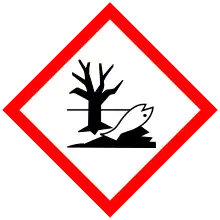 | |
| Names | |
|---|---|
| IUPAC name
Phenylsulfanylbenzene | |
| Identifiers | |
3D model (JSmol) |
|
| Abbreviations | Ph2S |
| 1907932 | |
| ChEBI | |
| ChEMBL | |
| ChemSpider | |
| ECHA InfoCard | 100.004.884 |
| EC Number |
|
| UNII | |
CompTox Dashboard (EPA) |
|
| |
| |
| Properties | |
| (C6H5)2S | |
| Molar mass | 186.27 g·mol−1 |
| Appearance | Colorless liquid |
| Density | 1.113 g/cm3 (20 °C)[1] Vapor: 6.42 (air = 1.0) |
| Melting point | −25.9 °C (−14.6 °F; 247.2 K) |
| Boiling point | 296 °C (565 °F; 569 K) |
| insoluble | |
| Solubility | Soluble in diethyl ether, benzene, carbon disulfide. |
| Vapor pressure | 0.01 hPa at 25 °C[2] |
Refractive index (nD) |
1.6327 |
| Viscosity |
|
| Structure | |
| Bent on the sulfur atom | |
| Hazards | |
| GHS labelling: | |
  | |
| Warning | |
| H302, H315, H319, H410 | |
| P264, P270, P273, P280, P301+P312, P301+P317, P302+P352, P305+P351+P338, P321, P330, P332+P317, P362+P364, P391, P501 | |
| Flash point | 113 °C (235 °F) |
| Lethal dose or concentration (LD, LC): | |
LD50 (median dose) |
|
| Related compounds | |
Related compounds |
|
Except where otherwise noted, data are given for materials in their standard state (at 25 °C [77 °F], 100 kPa).
Infobox references | |
Diphenyl sulfide is an organosulfur compound with the chemical formula (C6H5)2S, often abbreviated as Ph2S, where Ph stands for phenyl. It is a colorless liquid with an unpleasant odor. Diphenyl sulfide is an aromatic sulfide. The molecule consists of two phenyl groups attached to a sulfur atom.
Synthesis, reactions, occurrence
Many methods exist for the preparation of diphenyl sulfide. It arises by a Friedel-Crafts-like reaction of sulfur monochloride and benzene.[4]Diphenyl sulfide and its analogues can also be produced by coupling reactions using metal catalysts.[5] It can also be prepared by reduction of diphenyl sulfone.[6]
Diphenyl sulfide is a product of the photodegradation of the fungicide edifenphos.[7]
Diphenyl sulfide is a precursor to triarylsulfonium salts, which are used as photoinitiators. The compound can be oxidized to the sulfoxide with hydrogen peroxide.[8]
References
- ↑ "3". CRC Handbook of Chemistry and Physics (90 ed.). 2010. p. 220.
- 1 2 "GESTIS-Stoffdatenbank".
- ↑ "Diphenyl sulfide".
- ↑ Hartman, W. W.; Smith, L. A.; Dickey, J. B. (1934). "Diphenyl Sulfide". Organic Syntheses. 14: 36. doi:10.15227/orgsyn.014.0036.
- ↑ Lian, Zhong; Bhawal, Benjamin N.; Yu, Peng; Morandi, Bill (2017). "Palladium-catalyzed carbon-sulfur or carbon-phosphorus bond metathesis by reversible arylation". Science. 356 (6342): 1059–1063. Bibcode:2017Sci...356.1059L. doi:10.1126/science.aam9041. PMID 28596362. S2CID 206657928.
- ↑ Krafft, F.; Vorster, W. (1893). "Ueber Umwandlung des Diphenylsulfons in Diphenylsulfid und Diphenylselenid". Berichte der Deutschen Chemischen Gesellschaft. 26 (3): 2813–2822. doi:10.1002/cber.18930260393.
- ↑ Murai, Toshinobu (1977). "Photodecomposition of O -Ethyl S , S -Diphenyl Phosphorodithiolate (Edifenphos)". Agricultural and Biological Chemistry. 41: 71–77. doi:10.1080/00021369.1977.10862468.
- ↑ Sato, Kazuhiko; Hyodo, Mamoru; Aoki, Masao; Zheng, Xiao-Qi; Noyori, Ryoji (2001). "Oxidation of Sulfides to Sulfoxides and Sulfones with 30% Hydrogen Peroxide under Organic Solvent- and Halogen-Free Conditions". Tetrahedron. 57 (13): 2469–2476. doi:10.1016/s0040-4020(01)00068-0.